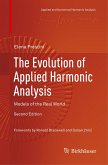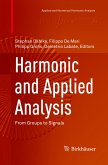This book is intended as an introduction to harmonic analysis and generalized Gelfand pairs. Starting with the elementary theory of Fourier series and Fourier integrals, the author proceeds to abstract harmonic analysis on locally compact abelian groups and Gelfand pairs. Finally a more advanced theory of generalized Gelfand pairs is developed.
This book is aimed at advanced undergraduates or beginning graduate students. The scope of the book is limited, with the aim of enabling students to reach a level suitable for starting PhD research. The main prerequisites for the book are elementary real, complex and functional analysis. In the later chapters, familiarity with some more advanced functional analysis is assumed, in particular with the spectral theory of (unbounded) self-adjoint operators on a Hilbert space.
From the contents
Fourier series
Fourier integrals
Locally compact groups
Haar measures
Harmonic analysis on locally compact abelian groups
Theory and examples of Gelfand pairs
Theory and examples of generalized Gelfand pairs
This book is aimed at advanced undergraduates or beginning graduate students. The scope of the book is limited, with the aim of enabling students to reach a level suitable for starting PhD research. The main prerequisites for the book are elementary real, complex and functional analysis. In the later chapters, familiarity with some more advanced functional analysis is assumed, in particular with the spectral theory of (unbounded) self-adjoint operators on a Hilbert space.
From the contents
Fourier series
Fourier integrals
Locally compact groups
Haar measures
Harmonic analysis on locally compact abelian groups
Theory and examples of Gelfand pairs
Theory and examples of generalized Gelfand pairs








